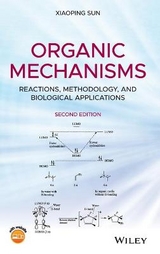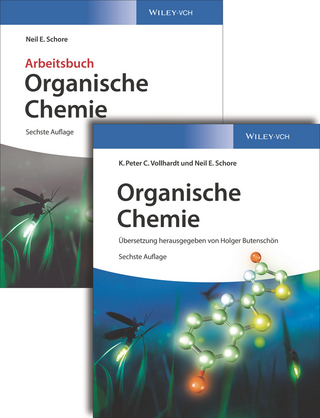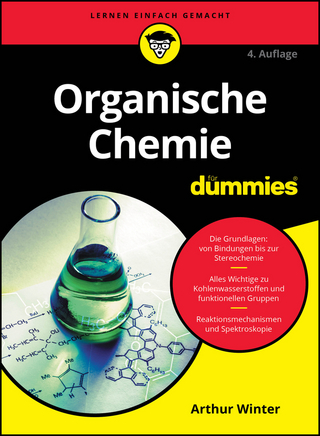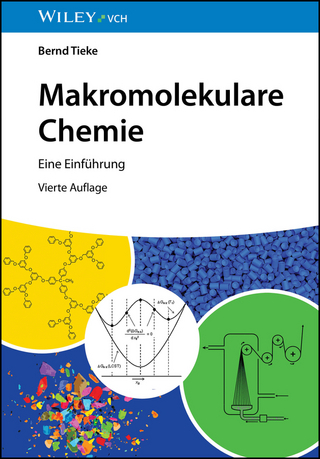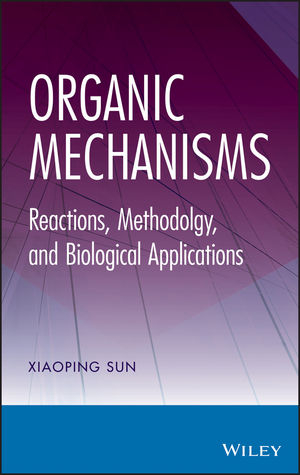
Organic Mechanisms
John Wiley & Sons Inc (Verlag)
978-1-118-06564-8 (ISBN)
- Titel ist leider vergriffen;
keine Neuauflage - Artikel merken
Emphasizing mechanistic aspects of organic reactions, Organic Mechanisms provides a useful guide for how to analyze, understand, approach, and solve the problems of organic reactions with the help of mechanistic studies. The author ties reaction mechanisms, synthetic methodology, and biochemical applications together and helps organic chemists improve the practice of synthetic reactions. With end-of-chapter problems and separate solutions manual, the book serves as a student-friendly textbook in advanced organic chemistry as well as a resource for practicing chemists.
XIAOPING SUN, PhD, is Professor of Chemistry at the University of Charleston. Dr. Sun has more than ten years of experience teaching advanced organic chemistry and biochemistry. His research focuses on studying the mechanisms of chemical reactions. Dr. Sun is the recipient of a research grant from the National Science Foundation.
Preface xiii 1 Fundamental Principles 1 1.1 Reaction Mechanisms and their Importance 1 1.2 Elementary (Concerted) and Stepwise Reactions 2 1.3 Molecularity 4 1.3.1 Unimolecular Reactions 4 1.3.2 Bimolecular Reactions 4 1.4 Kinetics 5 1.4.1 Rate Laws for Elementary (Concerted) Reactions 5 1.4.2 Reactive Intermediates and the Steady-State Assumption 9 1.4.3 Rate Laws for Stepwise Reactions 12 1.5 Thermodynamics 13 1.5.1 Enthalpy, Entropy, and Free Energy 13 1.5.2 Reversible and Irreversible Reactions 14 1.5.3 Chemical Equilibrium 15 1.6 The Transition State 17 1.7 The Molecular Orbital Theory 19 1.7.1 Formation of Molecular Orbitals from Atomic Orbitals 19 1.7.2 Molecular Orbital Diagrams 25 1.7.3 Resonance Stabilization 25 1.7.4 Frontier Molecular Orbitals 28 1.8 Electrophiles/Nucleophiles versus Acids/Bases 29 1.8.1 Common Electrophiles 29 1.8.2 Common Nucleophiles 33 1.9 Isotope Labeling 35 Problems 38 References 40 2 The Aliphatic C H Bond Functionalization 41 2.1 Alkyl Radicals: Bonding and their Relative Stability 42 2.2 Radical Halogenations of the C H Bonds on sp3-Hybridized Carbons: Mechanism and Nature of the Transition States 47 2.3 Energetics of the Radical Halogenations of Alkanes and their Regioselectivity 51 2.3.1 Energy Profiles for Radical Halogenation Reactions of Alkanes 51 2.3.2 Regioselectivity for Radical Halogenation Reactions 52 2.4 Kinetics of Radical Halogenations of Alkanes 56 2.5 Radical Initiators 61 2.6 Transition-Metal-Compounds-Catalyzed Alkane C H Bond Activation and Functionalization 64 2.6.1 The C H Bond Activation via Agostic Bond 64 2.6.2 Mechanisms for the C H Bond Oxidative Functionalization 65 2.7 Superacids-Catalyzed Alkane C H Bond Activation and Functionalization 68 2.8 Nitration of Aliphatic C H Bonds via the Nitronium NO2 + Ion 69 2.9 Enzyme-Catalyzed Alkane C H Bond Activation and Functionalization: Biochemical Methods 71 Problems 75 References 77 3 Functionalization of the Alkene C C Bond by Electrophilic Additions 78 3.1 Markovnikov Additions via Intermediate Carbocations 79 3.1.1 Additions of Alkenes to Hydrogen Halides (HCl, HBr, and HI): Mechanism, Regiochemistry, and Stereochemistry 79 3.1.2 Acid- and Transition-Metal-Catalyzed Hydration of Alkenes and Its Applications 84 3.1.3 Acid-Catalyzed Additions of Alcohols to Alkenes 89 3.1.4 Special Electrophilic Additions of the Alkene C C Bond: Mechanistic and Synthetic Aspects 89 3.1.5 Electrophilic Addition to the C C Triple Bond via a Vinyl Cation Intermediate 94 3.2 Electrophilic Addition of Hydrogen Halides to Conjugated Dienes 95 3.3 Non-Markovnikov Radical Addition 96 3.4 Hydroboration: Concerted, Non-Markovnikov syn-Addition 97 3.4.1 Diborane (B2H6): Structure and Properties 97 3.4.2 Concerted, Non-Markovnikov syn-Addition of Borane (BH3) to the Alkene C C Bond: Mechanism, Regiochemistry, and Stereochemistry 98 3.4.3 Synthesis of Special Hydroborating Reagents 102 3.4.4 Reactions of Alkenes with Special Hydroborating Reagents: Regiochemistry, Stereochemistry, and their Applications in Chemical Synthesis 103 3.5 Transition-Metal-Catalyzed Hydrogenation of the Alkene C C Bond (syn-Addition) 107 3.5.1 Mechanism and Stereochemistry 107 3.5.2 Synthetic Applications 110 3.5.3 Biochemically-Related Applications: Hydrogenated Fats (Oils) 111 3.6 Halogenation of the Alkene C C Bond (Anti-Addition): Mechanism and Its Stereochemistry 113 Problems 117 References 120 4 Functionalization of the Alkene C C Bond by Cycloaddition Reactions 121 4.1 Cycloadditions of the Alkene C C Bond to Form Three-Membered Rings 122 4.1.1 Epoxidation 122 4.1.2 Cycloadditions via Carbenes and Related Species 124 4.2 Cycloadditions to Form Four-Membered Rings 128 4.3 Diels Alder Cycloadditions of the Alkene C C Bond to Form Six-Membered Rings 131 4.3.1 Frontier Molecular Orbital Interactions 132 4.3.2 Substituent Effects 135 4.3.3 Other Diels Alder Reactions 138 4.4 1,3-Dipolar Cycloadditions of the C C and other Multiple Bonds to Form Five-Membered Rings 142 4.4.1 Oxidation of Alkenes by Ozone (O3) and Osmium Tetraoxide (OsO4) via Cycloadditions 142 4.4.2 Cycloadditions of Nitrogen-Containing 1,3-Dipoles to Alkenes 145 4.4.3 Cycloadditions of Alkenes, Alkynes, and Nitriles to the Dithionitronium (NS2+) Ion: Making CNS-Containing Aromatic Heterocycles 147 4.5 Pericyclic Reactions 154 Problems 158 References 161 5 The Aromatic C H Bond Functionalization and Related Reactions 162 5.1 Aromatic Nitration: All Reaction Intermediates and Full Mechanism for the Aromatic C H Bond Substitution by Nitronium (NO2 +) and Related Electrophiles 163 5.1.1 Charge-Transfer Complex [ArH, NO2+] between Arene and Nitronium 164 5.1.2 Ion-Radical Pair [ArH+ , NO2] 164 5.1.3 Arenium [Ar(H)NO2]+ Ion 165 5.1.4 Full Mechanism for Aromatic Nitration 166 5.2 Mechanisms and Synthetic Utility for Aromatic C H Bond Substitutions by Other Related Electrophiles 167 5.3 The Electrophilic Aromatic C H Bond Substitution Reactions via SN1 and SN2 Mechanisms 174 5.3.1 Reactions Involving SN1 Steps 175 5.3.2 Reactions Involving SN2 Steps 179 5.4 Substituent Effects on the Electrophilic Aromatic Substitution Reactions 181 5.4.1 Ortho- and Para-Directors 183 5.4.2 Meta-Directors 185 5.5 Isomerizations Effected by the Electrophilic Aromatic Substitution Reactions 187 5.6 Electrophilic Substitution Reactions on the Aromatic Carbon Metal Bonds: Mechanisms and Synthetic Applications 191 5.7 Nucleophilic Aromatic Substitution via a Benzyne (aryne) Intermediate: Functional Group Transformations on Aromatic Rings 193 5.8 Nucleophilic Aromatic Substitution via an Anionic Meisenheimer Complex 197 5.9 Biological Applications of Functionalized Aromatic Compounds 200 Problems 204 References 207 6 Nucleophilic Substitutions on sp3-Hybridized Carbons: Functional Group Transformations 209 6.1 Nucleophilic Substitution on Mono-Functionalized sp3-Hybridized Carbon 209 6.2 Functional Groups which are Good and Poor Leaving Groups 211 6.3 Good and Poor Nucleophiles 213 6.4 SN2 Reactions: Kinetics, Mechanism, and Stereochemistry 215 6.4.1 Mechanism and Stereochemistry for SN2 Reactions 215 6.4.2 Steric Effect on SN2 Reactions 218 6.4.3 Effect of Nucleophiles 220 6.4.4 Solvent Effect 222 6.4.5 Effect of Unsaturated Groups Attached to the Functionalized Electrophilic Carbon 224 6.5 Analysis of the SN2 Mechanism Using Symmetry Rules and Molecular Orbital Theory 225 6.5.1 The SN2 Reactions of Methyl and Primary Haloalkanes RCH2X (X = Cl, Br, or I; R = H or an Alkyl Group) 225 6.5.2 Reactivity of Dichloromethane CH2Cl2 228 6.6 SN1 Reactions: Kinetics, Mechanism, and Product Development 229 6.6.1 The SN1 Mechanism and Rate Law 229 6.6.2 Solvent Effect 231 6.6.3 Effects of Carbocation Stability and Quality of Leaving Group on the SN1 Rates 231 6.6.4 Product Development for SN1 Reactions 235 6.7 Competition between SN1 and SN2 Reactions 237 6.8 Some Useful SN1 and SN2 Reactions: Mechanisms and Synthetic Perspectives 241 6.8.1 Nucleophilic Substitution Reactions Effected by Carbon Nucleophiles 241 6.8.2 Synthesis of Primary Amines 246 6.8.3 Synthetic Utility of Triphenylphosphine: A Strong Phosphorus Nucleophile 247 6.8.4 Neighboring Group-Assisted SN1 Reactions 247 6.9 Biological Applications of Nucleophilic Substitution Reactions 251 6.9.1 Biomedical Applications 251 6.9.2 Biosynthesis Involving Nucleophilic Substitution Reactions 253 6.9.3 An Enzyme-Catalyzed Nucleophilic Substitution of a Haloalkane 255 Problems 256 References 259 7 Eliminations 260 7.1 E2 Elimination: Bimolecular -Elimination of H/LG and Its Regiochemistry and Stereochemistry 261 7.1.1 Mechanism and Regiochemistry 261 7.1.2 E2 Eliminations of Functionalized Cycloalkanes 264 7.1.3 Stereochemistry 267 7.2 Analysis of the E2 Mechanism Using Symmetry Rules and Molecular Orbital Theory 268 7.3 Basicity versus Nucleophilicity for Various Anions 271 7.4 Competition of E2 and SN2 Reactions 274 7.5 E1 Elimination: Stepwise -Elimination of H/LG via an Intermediate Carbocation and Its Rate Law 276 7.5.1 Mechanism and Rate Law 276 7.5.2 E1 Dehydration of Alcohols 278 7.5.3 E1 Elimination of Functionalized Alkanes 281 7.6 Special -Elimination Reactions 283 7.7 Elimination of LG1/LG2 in the Compounds that Contain Two Functional Groups 286 7.8 -Elimination Giving a Carbene: A Mechanistic Analysis Using Symmetry Rules and Molecular Orbital Theory 288 7.9 E1cb Elimination and its Biological Applications 288 7.9.1 The E1cb Mechanism 288 7.9.2 Biological Applications 291 Problems 294 References 297 8 Nucleophilic Additions and Substitutions on Carbonyl Groups 298 8.1 Nucleophilic Additions and Substitutions of Carbonyl Compounds 298 8.2 Nucleophilic Additions of Aldehydes and Ketones and their Biological Applications 301 8.2.1 Acid- and Base-Catalyzed Hydration of Aldehydes and Ketones 301 8.2.2 Acid-Catalyzed Nucleophilic Additions of Aldehydes and Ketones to Alcohols 303 8.2.3 Biological Applications: Cyclic Structures of Carbohydrates 307 8.2.4 Addition of Sulfur Nucleophile to Aldehydes 311 8.2.5 Nucleophilic Addition of Amines to Ketones and Aldehydes 311 8.2.6 Nucleophilic Additions of Aldehydes and Ketones to Hydride Donors: Organic Reductions 315 8.3 Biological Hydride Donors NAD(P)H and FADH2 316 8.4 Activation of Carboxylic Acids via Nucleophilic Substitutions on the Carbonyl Carbons 320 8.4.1 Reactions of Carboxylic Acids with Thionyl Chloride 320 8.4.2 Esterification Reactions and Synthetic Applications 321 8.4.3 Formation of Anhydrides 325 8.4.4 Nucleophilic Addition to Alkyllithium 326 8.5 Nucleophilic Substitutions of Acyl Derivatives and their Biological Applications 327 8.5.1 Nucleophilic Substitutions of Acyl Chlorides and Anhydrides 327 8.5.2 Hydrolysis and Other Nucleophilic Substitutions of Esters 329 8.5.3 Biodiesel Synthesis and Reaction Mechanism 331 8.5.4 Biological Applications 332 8.6 Reduction of Acyl Derivatives by Hydride Donors 335 8.7 Kinetics of the Nucleophilic Addition and Substitution of Acyl Derivatives 337 Problems 340 References 342 9 Reactivity of the -Hydrogen to Carbonyl Groups 344 9.1 Formation of Enolates and their Nucleophilicity 344 9.1.1 Formation of Enolates 344 9.1.2 Molecular Orbitals and Nucleophilicity of Enolates 348 9.2 Alkylation of Carbonyl Compounds (Aldehydes, Ketones, and Esters) via Enolates and Hydrazones 349 9.2.1 Alkylation via Enolates 349 9.2.2 Alkylation via Hydrazones and Enamines 351 9.3 Aldol Reactions 354 9.3.1 Mechanism and Synthetic Utility 354 9.3.2 Stereoselectivity 361 9.3.3 Other Synthetic Applications 364 9.4 Acylation Reactions of Esters via Enolates: Mechanism and Synthetic Utility 367 9.5 Roles of Enolates in Metabolic Processes in Living Organisms 373 Problems 376 References 378 10 Rearrangements 380 10.1 Major Types of Rearrangements 380 10.2 Rearrangement of Carbocations: 1,2-Shift 381 10.2.1 1,2-Shifts in Carbocations Produced from Acyclic Molecules 382 10.2.2 1,2-Shifts in Carbocations Produced from Cyclic Molecules Ring Expansion 383 10.2.3 Resonance Stabilization of Carbocation Pinacol Rearrangement 385 10.2.4 In vivo Cascade Carbocation Rearrangements: Biological Significance 387 10.2.5 Acid-Catalyzed 1,2-Shift in Epoxides 388 10.2.6 Anion-Initiated 1,2-Shift 389 10.3 Neighboring Leaving Group-Facilitated 1,2-Rearrangement 390 10.3.1 Beckmann Rearrangement 391 10.3.2 Hofmann Rearrangement 393 10.3.3 Baeyer Villiger Oxidation (Rearrangement) 394 10.3.4 Acid-Catalyzed Rearrangement of Organic Peroxides 396 10.4 Carbene Rearrangement: 1,2-Rearrangement of Hydrogen Facilitated by a Lone Pair of Electrons 399 10.5 Claisen Rearrangement 401 10.6 Photochemical Isomerization of Alkenes and its Biological Applications 403 10.6.1 Photochemical Isomerization 403 10.6.2 Biological Relevance 404 10.7 Rearrangement of Carbon Nitrogen Sulfur-Containing Heterocycles 405 Problems 409 References 411 Index 413
| Erscheint lt. Verlag | 13.8.2013 |
|---|---|
| Verlagsort | New York |
| Sprache | englisch |
| Maße | 152 x 253 mm |
| Gewicht | 744 g |
| Themenwelt | Naturwissenschaften ► Chemie ► Organische Chemie |
| ISBN-10 | 1-118-06564-6 / 1118065646 |
| ISBN-13 | 978-1-118-06564-8 / 9781118065648 |
| Zustand | Neuware |
| Haben Sie eine Frage zum Produkt? |
aus dem Bereich
